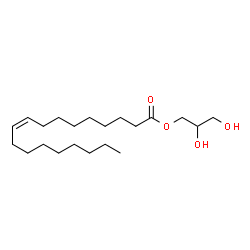Monoolein

Monoolein structure
|
Common Name | Monoolein | ||
|---|---|---|---|---|
| CAS Number | 111-03-5 | Molecular Weight | 356.540 | |
| Density | 0.9407 g/cm3 (35 ºC) | Boiling Point | 483.3±35.0 °C at 760 mmHg | |
| Molecular Formula | C21H40O4 | Melting Point | 38.5 ºC (acetone ) | |
| MSDS | Chinese USA | Flash Point | 155.4±19.4 °C | |
|
Profiling of regioisomeric triacylglycerols in edible oils by supercritical fluid chromatography/tandem mass spectrometry.
J. Chromatogr. B. Analyt. Technol. Biomed. Life Sci. 966 , 193-9, (2014) In this study, supercritical fluid chromatography (SFC) coupled with triple quadrupole mass spectrometry was applied to the profiling of several regioisomeric triacylglycerols (TAGs). SFC conditions (column, flow rate, modifier) were optimized for the effecti... |
|
|
Identification of a novel hypocholesterolemic protein, major royal jelly protein 1, derived from royal jelly.
PLoS ONE 9(8) , e105073, (2014) Royal jelly (RJ) intake lowers serum cholesterol levels in animals and humans, but the active component in RJ that lowers serum cholesterol level and its molecular mechanism are unclear. In this study, we set out to identify the bile acid-binding protein cont... |
|
|
Cell-free expression and in meso crystallisation of an integral membrane kinase for structure determination.
Cell. Mol. Life Sci. 71(24) , 4895-910, (2014) Membrane proteins are key elements in cell physiology and drug targeting, but getting a high-resolution structure by crystallographic means is still enormously challenging. Novel strategies are in big demand to facilitate the structure determination process t... |
|
|
Two step esterification-transesterification process of wet greasy sewage sludge for biodiesel production.
Bioresour. Technol. 200 , 1044-9, (2015) Sewage sludge generated in municipal wastewater treatment plants was used as a feedstock for biodiesel production via esterification/transesterification in a two-step process. In the first esterification step, greasy and secondary sludge were tested using aci... |
|
|
Intestinal scavenger receptors are involved in vitamin K1 absorption.
J. Biol. Chem. 289(44) , 30743-52, (2014) Vitamin K1 (phylloquinone) intestinal absorption is thought to be mediated by a carrier protein that still remains to be identified. Apical transport of vitamin K1 was examined using Caco-2 TC-7 cell monolayers as a model of human intestinal epithelium and in... |
|
|
Specific cellular incorporation of a pyrene-labelled cholesterol: lipoprotein-mediated delivery toward ordered intracellular membranes.
PLoS ONE 10(4) , e0121563, (2015) In the aim of testing tools for tracing cell trafficking of exogenous cholesterol, two fluorescent derivatives of cholesterol, 22-nitrobenzoxadiazole-cholesterol (NBD-Chol) and 21-methylpyrenyl-cholesterol (Pyr-met-Chol), with distinctive chemico-physical cha... |
|
|
A single step reversed-phase high performance liquid chromatography separation of polar and non-polar lipids.
J. Chromatogr. A. 1369 , 105-15, (2014) This paper reports a simple chromatographic system to separate lipids classes as well as their molecular species. By the use of phenyl coated silica as stationary phase in combination with a simple mobile phase consisting of methanol and water, all tested lip... |
|
|
How relevant are assembled equilibrium samples in understanding structure formation during lipid digestion?
Eur. J. Pharm. Biopharm. 96 , 117-24, (2015) Lipid-based formulations are gaining interest for use as drug delivery systems for poorly water-soluble drug compounds. During digestion, the lipolysis products self-assemble with endogenous surfactants in the gastrointestinal tract to form colloidal structur... |
|
|
In vitro and in vivo evaluations of the performance of an indirubin derivative, formulated in four different self-emulsifying drug delivery systems.
J. Pharm. Pharmacol. 66(11) , 1567-75, (2014) Anticancer indirubins are poorly soluble in water. Here, digestion of four self-emulsifying drug delivery systems (SEDDS) containing E804 (indirubin-3'-oxime 2,3-dihydroxypropyl ether) was compared by dynamic lipolysis and bioavailability studies. Used lipids... |
|
|
Structural basis for the facilitative diffusion mechanism by SemiSWEET transporter.
Nat. Commun. 6 , 6112, (2015) SWEET family proteins mediate sugar transport across biological membranes and play crucial roles in plants and animals. The SWEETs and their bacterial homologues, the SemiSWEETs, are related to the PQ-loop family, which is characterized by highly conserved pr... |